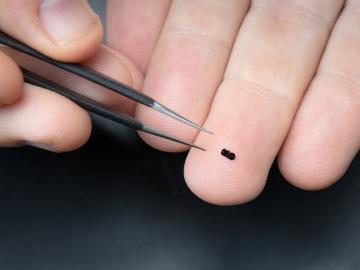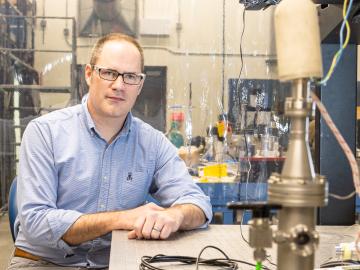
Filter News
Area of Research
- (-) Materials (54)
- (-) National Security (22)
- (-) Neutron Science (30)
- (-) Nuclear Science and Technology (11)
- Advanced Manufacturing (2)
- Biological Systems (1)
- Biology and Environment (36)
- Computational Biology (2)
- Computational Engineering (2)
- Computer Science (7)
- Electricity and Smart Grid (1)
- Energy Frontier Research Centers (1)
- Energy Science (32)
- Functional Materials for Energy (1)
- Fusion and Fission (5)
- Isotope Development and Production (1)
- Isotopes (10)
- Materials for Computing (9)
- Quantum information Science (1)
- Sensors and Controls (1)
- Supercomputing (69)
News Topics
- (-) Artificial Intelligence (24)
- (-) Big Data (8)
- (-) Biomedical (22)
- (-) Molten Salt (7)
- (-) Nanotechnology (43)
- (-) Security (12)
- (-) Space Exploration (10)
- 3-D Printing/Advanced Manufacturing (32)
- Advanced Reactors (15)
- Bioenergy (20)
- Biology (14)
- Biotechnology (2)
- Buildings (6)
- Chemical Sciences (34)
- Clean Water (4)
- Composites (9)
- Computer Science (42)
- Coronavirus (16)
- Critical Materials (13)
- Cybersecurity (21)
- Energy Storage (39)
- Environment (26)
- Exascale Computing (2)
- Fossil Energy (1)
- Frontier (4)
- Fusion (17)
- Grid (11)
- High-Performance Computing (10)
- Hydropower (1)
- Irradiation (1)
- Isotopes (16)
- ITER (1)
- Machine Learning (18)
- Materials (81)
- Materials Science (88)
- Mathematics (1)
- Microscopy (27)
- National Security (35)
- Neutron Science (129)
- Nuclear Energy (53)
- Partnerships (15)
- Physics (31)
- Polymers (18)
- Quantum Computing (4)
- Quantum Science (16)
- Simulation (2)
- Summit (7)
- Transportation (21)
Media Contacts

A novel approach developed by scientists at ORNL can scan massive datasets of large-scale satellite images to more accurately map infrastructure – such as buildings and roads – in hours versus days.

Rigoberto “Gobet” Advincula has been named Governor’s Chair of Advanced and Nanostructured Materials at Oak Ridge National Laboratory and the University of Tennessee.

Liam Collins was drawn to study physics to understand “hidden things” and honed his expertise in microscopy so that he could bring them to light.

A typhoon strikes an island in the Pacific Ocean, downing power lines and cell towers. An earthquake hits a remote mountainous region, destroying structures and leaving no communication infrastructure behind.

Students often participate in internships and receive formal training in their chosen career fields during college, but some pursue professional development opportunities even earlier.

Researchers at ORNL and the National Renewable Energy Laboratory took inspiration from flying insects to demonstrate a miniaturized gyroscope, a special sensor used in navigation technologies.

If humankind reaches Mars this century, an Oak Ridge National Laboratory-developed experiment testing advanced materials for spacecraft may play a key role.

IDEMIA Identity & Security USA has licensed an advanced optical array developed at Oak Ridge National Laboratory. The portable technology can be used to help identify individuals in challenging outdoor conditions.

A new method developed at Oak Ridge National Laboratory improves the energy efficiency of a desalination process known as solar-thermal evaporation.

OAK RIDGE, Tenn., March 20, 2019—Direct observations of the structure and catalytic mechanism of a prototypical kinase enzyme—protein kinase A or PKA—will provide researchers and drug developers with significantly enhanced abilities to understand and treat fatal diseases and neurological disorders such as cancer, diabetes, and cystic fibrosis.


